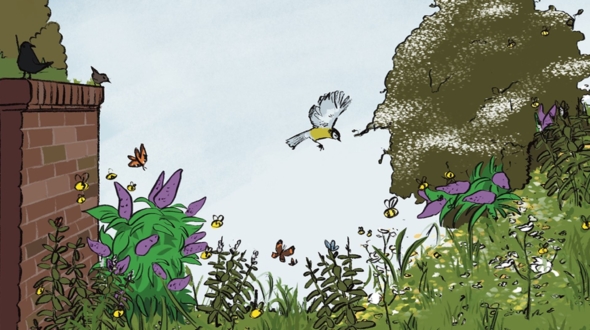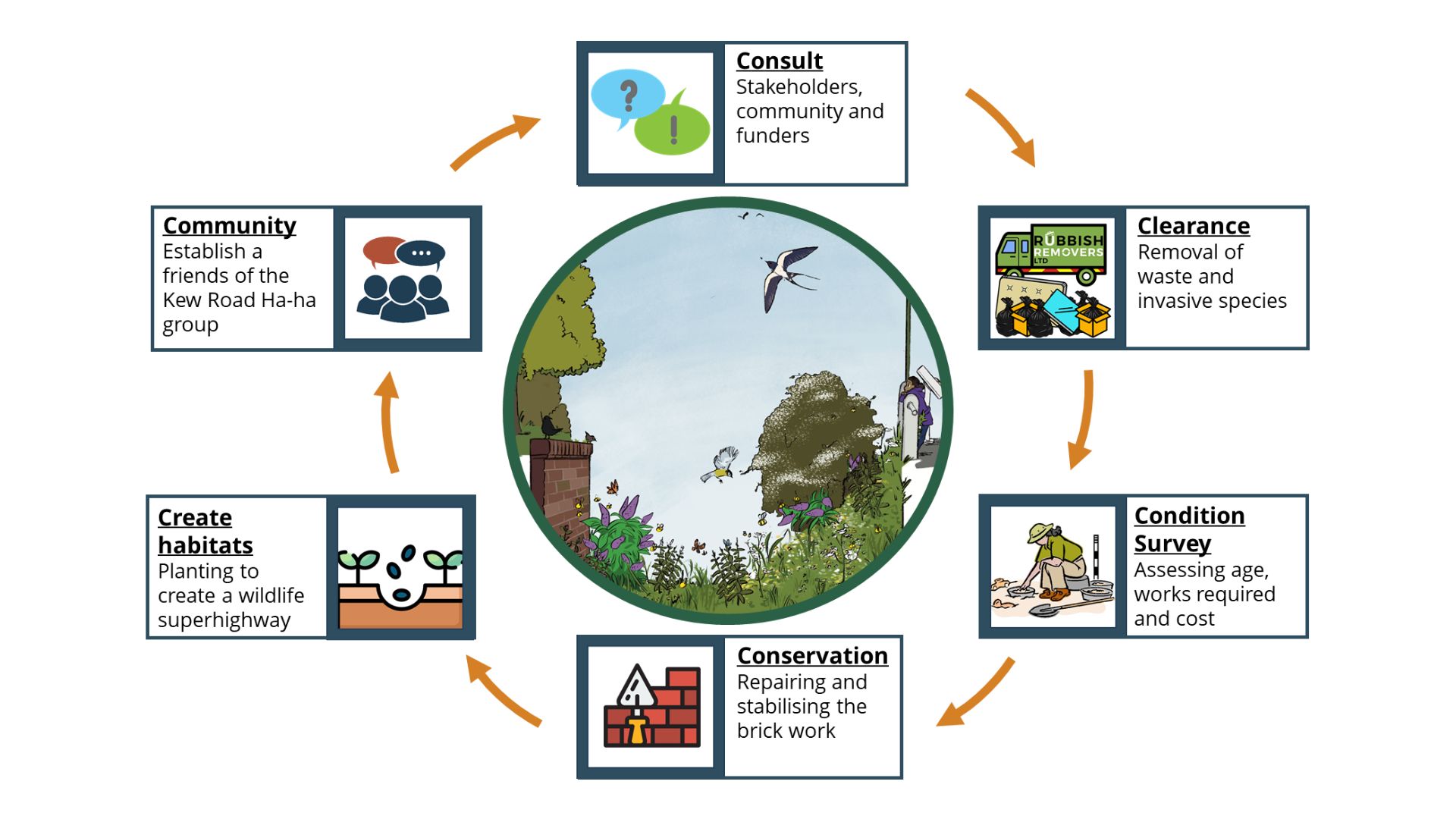Kew Road Ha-ha

Habitats & Heritage are expanding our Green Hub project at the Kew Road Ha-ha to repair the historic wall and create a native wildlife corridor.
How we will look after the Kew Road Ha-ha:

Our Conservation Plan
The Kew Road ha-ha is in a terrible and unstable condition, with fallen bricks and self-seeded or dead trees. Habitats & Heritage is embarking on a project that clears the invasive species and dangerous trees, restoring the wall and creating a native wildlife corridor.
We will research the ha-ha to gain a better understanding of its history and relationship with the wider landscape, including the part it played in George III and Queen Charlotte’s royal residence at Richmond. We will also create a training and apprenticeship programme, led by a conservation professional who will host weekend working parties where you can get involved and learn how to restore a historic brick wall.
Clearing the ha-ha of rubbish, problem trees and invasive species, we will establish a wildlife corridor that supports our native species such as hedgehogs, butterflies and beetles. We will create an educational trail and signboards that link the ha-ha with surrounding landscapes and nature conservation sites. Working with the Royal Botanic Gardens at Kew, Old Deer Park Sports Ground and the local community we will create a nature haven that supports plentiful and diverse species.

What is a Ha-ha?
A ha-ha is a landscape device composed of a ditch that slopes upwards, with a dry-stone or brick wall built up to ground level on the inner side. Designed to create a natural barrier within a landscape, it was used to both divide agricultural and recreational grounds and cultivate a more natural landscape, with wide, sweeping vistas.
The ha-ha was originally designed in France in the early eighteenth century, and the name is said to derive from the cry of surprise visitors had on stumbling across the concealed ditch. It quickly became popular in England from 1712, driven by Georgian love of tricks and devices.
Wildlife in the Ha-ha
[COMING SOON]


History of the Ha-ha
Kew Road Ha-ha is part of the complex landscape of Old Deer Park and Kew Gardens. James I established Old Deer Park in the early 17th century as a hunting ground for his royal residence at Richmond Palace, expanding the crown estate and establishing a Keeper’s Lodge. The Palace falling into ruin, it was not until 1717 that the area became popular with the monarchy once more, with George II and Queen Caroline establishing summer residence at the lodge and renaming it Richmond Lodge.
Queen Caroline carried out huge improvements to the landscape, forming Richmond Gardens with the famous designers of the day, William Kent and Charles Bridgeman. Bridgeman is widely considered to have introduced the ha-ha to England, and it is possible that Kew Road Ha-ha was part of his designs. When George III and Queen Charlotte took over the Richmond Estate, they moved to the White House in the newly establish Kew Gardens. Lancelot ‘Capability’ Brown was made royal gardener in 1764 and redesigned the grounds at Richmond and Kew in his trademark Arcadian style. Brown created a more informal landscape, using sweeping vistas and softening outlines, including installing ha-has along the river boundary. It is possible that Brown was also established the ha-ha at Kew Road.
The area surrounding Kew Road Ha-ha was used as pastureland from the eighteenth century with Peter Burrell’s 1771 map suggests that William Selwyn leased the land that is now the Old Deer Park Sports Ground from the crown estate for farmland. The Royal Botanic Gardens, Kew was formally established in 1841, with the Old Deer Park falling under the control of the Commissioner of Woods and Forests, later the Crown Estate Commissioners.
Sports clubs were first established on the site in the mid-nineteenth century. The earliest club was the Richmond Cricket Club in 1865 by Kew Foot Road. The Old Deer Park boundary wall runs from the entrance to the London Scottish Rugby Club, which moved to the Richmond Athletic Ground in 1892, and joins with the entrance to the Old Deer Park Sports Grounds and the Kew Road ha-ha. The Rosslyn Park Rugby Club was established in 1894, replaced by the London Welsh in 1957. From 1914 to 1932 the eastern area of Old Deer Park was used as allotments for Richmond and Kew residents, and it has been known to find a stray leek in the ha-ha.
Keep in touch!
Sign up for our monthly newsletter and be first to hear all the news, opportunities and events from the Habitats & Heritage community



